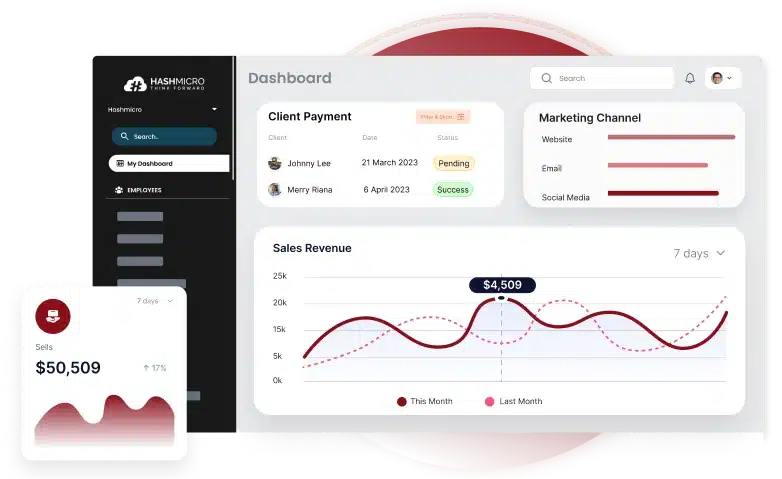It’s well-known that CRM implementation can really help businesses grow. Both small and large companies have seen their revenue increase with this tool. A CRM helps by automating tasks related to customers.
Without it, you’d probably use Excel sheets, sticky notes, or stacks of paper to store customer information, which is admittedly a messy and inefficient way of working. No wonder CRM systems are now so popular!
But, many companies forget that choosing the right CRM isn’t easy. If you’re not careful, the system might not work as expected and could end up being a failed investment, sayang naman.
So, how do you find the right CRM among all the vendors out there? This article will cover 10 key steps that every company should follow before picking a CRM.
Key Takeaways
|
Table of Contents

What is CRM Implementation?
Customer relationship management (CRM) is a tool for keeping track of interactions with customers and leads by organizing and updating customer information. The main goal of CRM is to improve customer relationships and help your business grow across areas like sales, service, marketing, and IT.
Implementing a CRM is done by setting up software to collect and organize important customer data, of which your sales and marketing teams can use to improve promotional efforts. Thus, and excellent use of CRM will be beneficial for personalized approaches, which will lead to more closing deals and sales.
CRMs store essential buyer details, including contact information, job titles, email addresses, interaction history, and purchase records. Many CRMs now also have built-in AI features, which can greatly improve customer relationship management.
Benefits of CRM Implementation
The main advantage of CRM software is that it helps manage customer interactions and relationships. For most sales-focused businesses, a CRM is essential for organizing large amounts of data and contact details needed to drive successful sales efforts.
Here are four of the main benefits of CRM implementation:
1. Boosted Revenue Growth
Using CRM system effectively can increase revenue. Harvard Business Review notes that 52% of top salespeople maximize their CRM tools, which helps boost productivity and results. By streamlining sales efforts and providing valuable insights, a CRM allows sales teams to focus on high-impact activities that directly contribute to revenue growth.
2. Higher Customer Retention and Satisfaction
With an effective CRM, companies can retain more customers and improve satisfaction. Personalized communication and tailored services lead to happier customers and greater loyalty. Additionally, CRM tools help reduce customer loss by allowing companies to address needs and issues proactively.
3. Easier Sales Pipeline Management
A strong CRM simplifies each step of the sales process. By knowing where each contact is in the pipeline, sales teams can send the right messages and move prospects along more quickly, helping to close deals faster.
This clear pipeline visibility ensures that no lead is overlooked, maximizing conversion opportunities and improving overall sales efficiency.
4. Time Savings
Studies show that sales reps spend about two-thirds of their time on tasks like data entry, which don’t generate revenue. A CRM can cut down on these tasks so that sales reps can spend more time on sales activities. With automated data handling and task management, a CRM frees up time for sales reps to engage with clients and close more deals.
10 Steps to a Successful CRM Implementation
To successfully implement a CRM, you need a clear plan with these essential steps:
1. Form CRM Selection and Implementation Teams
Bring together key stakeholders, including IT, sales, and marketing, to choose the CRM and manage its setup. Ensure teams cover technical needs, system maintenance, and user experience, and appoint project managers and senior leaders to help with decision-making.
Also identify what industry you work in; a retail industry might need a specialized retail CRM software, whereas real estate and property will need another specific CRM solution. Of course, the general CRM works just fine. However, there might be missing essential features if you don’t use a specialized one, especially if your industry is niche.
2. Define CRM Goals, Needs, and Budget
Determine your CRM goals, such as improving lead capture or boosting team productivity. Identify necessary features (like email tools, analytics, and lead tracking), separate must-haves from nice-to-haves, and set a realistic budget that considers both immediate and future needs.
Consider how a CRM could help your business reach its goals and tackle obstacles. What’s driving your search for a new system? Is your goal to help your sales team nurture leads? Do you want to elevate the support you provide to customers? Could a CRM reduce the time spent on administrative tasks?
3. Identify Needed Integrations
Choose a CRM that integrates well with your existing software (e.g., email, calendar, and essential platforms like Zoom and Slack) to ensure smooth workflows. Para laging maayos ang takbo ng trabaho, select a CRM that fits seamlessly with your tools. Additionally, integrating lead management software can enhance your CRM’s functionality by optimizing your lead qualification and nurturing process.
4. Evaluate CRM Options
Research CRM solutions that match your needs. Utilize free trials and demos, and, if needed, consult with a CRM expert to assist in evaluating platforms based on features and functionality. While features matter, there are other key factors to weigh:
- Customization: Can the platform adapt to your needs with options like custom fields and filters?
- Workflows: Will it maintain a smooth client record through each project stage? An integrated CRM should unify the client journey.
- Pricing: Is it within budget? Consider if it could also replace any unused or underutilized tools.
- Integrations: Does it connect with your essential tools to help simplify your processes?
5. Select the Best CRM Solution
After narrowing down choices, request a final demo from the top contenders. This final step helps clarify options and ensure the chosen CRM aligns with your team’s needs.
6. Prepare Data for Transition
Ensure your existing data is accurate before transferring it to the new CRM system, as unclean data can lead to significant issues post-migration.
7. Test the CRM
Before launching company-wide, test the CRM to verify data integrity, functionality, and user experience. Address any problems to prevent larger issues after going live.
8. Develop Training and Support Plans
Adopting a new system is always challenging, and some team members may embrace change more readily than others. That’s why it’s essential to communicate openly with everyone about the transition and reassure them that they’ll have the resources to integrate this new technology into their daily work.
Create a training program that covers all user levels. Consider provider-led training and designate internal experts to support new users.
9. Launch the CRM
Even with good guidance, unexpected issues or scope changes can still come up. It’s smart to catch any potential problems before your new system goes live. Try running a beta test with a small group to find any data migration gaps or extra training needs.
Your implementation experts will help set a launch date and plan any needed calls beforehand, but having an internal support system for any surprises is also helpful. Having a main person on your team to communicate about the implementation can keep things running smoothly.
10. Monitor and Refine
It’s easy to want to jump to the next task once the new platform is set up, but those first few months are key. Schedule team check-ins to gather feedback, catch any emerging issues, and make sure everyone is making the most of key features.
Also, be sure everyone has full access to platform support. Familiarize yourself with the CRM’s support options, read through any articles or updates they send, and connect with other users in online communities to solve more specific issues.
Starting Out with Tools for CRM Implementation
HashMicro’s CRM is designed to meet the needs of Filipino businesses by offering flexibility to fit local practices, integration with financial tools for easier cash flow management and scalability to support growth.
With a user-friendly interface, it’s simple for all team members to adopt, and it helps strengthen customer relationships by enabling personalized communication and tracking. Para hindi mahuli sa kumpetisyon, here’s a list of HashMicro Sales CRM features:
- Integrated with WhatsApp Channels – Direct integration with WhatsApp is a big plus, especially in markets where WhatsApp is commonly used, as it allows for instant communication with leads and customers.
- CRM Mobile Apps with Offline Mode – This feature is great for on-the-go accessibility, allowing users to access and update CRM data even without the internet, which is very valuable for sales teams working in various locations.
- Salesperson GPS Tracking – Real-time tracking of sales reps adds a layer of accountability and helps managers understand sales team activity and location-based performance.
- Automated Scoring to Assess Lead Quality – Automated lead scoring can prioritize high-quality leads, making it easier to focus on prospects most likely to convert.
- In-Depth CRM Reports – The ability to generate comprehensive reports (Lead Lifetime, Follow-Ups, GPS, Activity KPIs) provides valuable insights for data-driven decisions and tracking key performance indicators.
- Multi Salesperson per Lead – Assigning multiple salespeople to one lead fosters collaboration and ensures that prospects are fully covered, increasing the likelihood of successful conversion.
Conclusion
CRM implementation helps businesses organize customer data, streamline processes, and improve team productivity across sales and marketing. With a well-chosen CRM system, companies can enhance customer relationships and increase revenue effectively.
For Filipino businesses, HashMicro’s CRM offers all-in-one features, perfect for managing customers and supporting business growth. Its flexibility and seamless integration with tools like accounting systems make it a smart choice for growing companies.
Using HashMicro’s CRM, you’ll easily connect with customers, optimize sales processes, and keep track of key metrics. “Kayang-kaya mo ‘to, basta’t may tamang kasangkapan!” With a user-friendly interface and offline access, it’s designed to simplify work and boost results.
What are you waiting for? Try the free demo now!
FAQ About CRM Implementation
-
What are the common challenges faced during CRM implementation?
Common challenges include data migration issues, user adoption resistance, inadequate training, and integration difficulties with existing systems. Addressing these proactively can lead to a smoother implementation process.
-
How long does it typically take to implement a CRM system?
The duration varies based on the organization’s size and complexity but generally ranges from a few weeks to several months. Proper planning and resource allocation can help streamline the timeline.
-
How can we ensure high user adoption rates for the new CRM system?
Ensuring high user adoption involves providing comprehensive training, involving users in the selection process, demonstrating the system’s benefits, and offering continuous support to address any concerns.
-
What are the costs associated with CRM implementation?
Costs can include software licensing fees, customization expenses, training, data migration, and ongoing maintenance. It’s essential to budget for both initial setup and long-term operational costs.


































